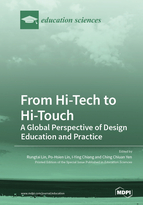From Hi-Tech to Hi-Touch: A Global Perspective of Design Education and Practice
A special issue of Education Sciences (ISSN 2227-7102).
Deadline for manuscript submissions: closed (30 November 2022) | Viewed by 34630
Special Issue Editors
Interests: ergonomics in product design; human–computer interaction; design education and cognitive approach in design; cultural and creative product design
Special Issues, Collections and Topics in MDPI journals
Interests: wooden crafts; art theory; art education; aesthetics
Special Issues, Collections and Topics in MDPI journals
Interests: craft and design education; cultural product design; metal arts and contemporary jewelry; placemaking
Special Issues, Collections and Topics in MDPI journals
2. Keio-NUS CUTE Center, National University of Singapore, Singapore 117602, Singapore
Interests: design in medicine; technology enabled learning; human–computer interaction
Special Issues, Collections and Topics in MDPI journals
Special Issue Information
Dear Colleagues,
Facing the change and impact of globalization, how to apply design thinking to improve people’s life, from Hi-tech to Hi-touch, is becoming increasingly vital during this disquieting era. This Special Issue is focused on discussing the development, application, potential and boundary of design education as well as design practice from a cross-cultural perspective. Thus, theoretical research via scrupulous literature review in various scope of design, empirical studies of significant design cases are welcome.
Potential topics include, but are not limited to:
- Frameworks for design education with creativity and critical thinking;
- Significant teaching and learning sequences of design;
- The theoretics and practice within design education approaches;
- Design education of cross-discipline;
- Teacher training for design;
- Design implementation for cross-culture;
- Research of creative design strategy;
- Design for placemaking;
- Special topic of design case study.
Reference
- Cross, N. (2011). Design Thinking: understanding how designers think and work, Berg/Bloomsbury, Oxford and New York. ISBN 978 184788 6378 (hb), 978 1847886361 (pb)
- Lin, R.-T. (2007). Transforming Taiwan aboriginal cultural features into modern product design: A case study of a cross- cultural product design model. International Journal of Design, 1(2), 47-55.
- Norman D. (2010, 2018). Why Design Education Must Change, https://www.core77.com/posts/17993/why-design-education-must-change-17993, https://jnd.org/why_design_education_must_change/.
- Shneiderman, B. (2016). The New ABCs of Research: Achieving Breakthrough Collaborations, Oxford University Press, Oxford, UK.
Prof. Dr. Rungtai Lin
Prof. Dr. Po-Hsien Lin
Prof. I-Ying Chiang
Dr. Ching Chiuan Yen
Guest Editors
Manuscript Submission Information
Manuscripts should be submitted online at www.mdpi.com by registering and logging in to this website. Once you are registered, click here to go to the submission form. Manuscripts can be submitted until the deadline. All submissions that pass pre-check are peer-reviewed. Accepted papers will be published continuously in the journal (as soon as accepted) and will be listed together on the special issue website. Research articles, review articles as well as short communications are invited. For planned papers, a title and short abstract (about 100 words) can be sent to the Editorial Office for announcement on this website.
Submitted manuscripts should not have been published previously, nor be under consideration for publication elsewhere (except conference proceedings papers). All manuscripts are thoroughly refereed through a double-blind peer-review process. A guide for authors and other relevant information for submission of manuscripts is available on the Instructions for Authors page. Education Sciences is an international peer-reviewed open access monthly journal published by MDPI.
Please visit the Instructions for Authors page before submitting a manuscript. The Article Processing Charge (APC) for publication in this open access journal is 1800 CHF (Swiss Francs). Submitted papers should be well formatted and use good English. Authors may use MDPI's English editing service prior to publication or during author revisions.
Keywords
- design education
- design thinking
- design strategy
- cross-culture design









